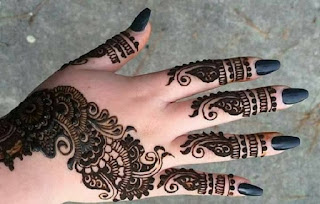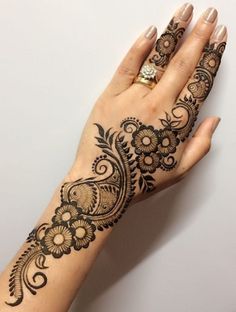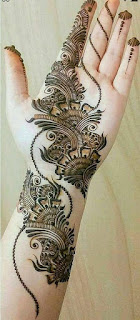
Mehendi or Hinna as an impermanent type of skin adornment, generally mainstream in South Asia, the Middle East, North Africa, and Somaliland, just as exile networks from these territories. It is regularly utilized for festivities and unique events, especially weddings. Henna plans are normally drawn on all fours, where the shading will be darkest in light of the fact that the skin contains more significant levels of keratin. The leaves of the henna plant contain a red-orange color particle, lawsone, which has a liking for holding with protein and has been utilized to color skin, hair, fingernails, calfskin, silk, and fleece. Henna leaves are normally dried and ground into a powder, which is blended into the glue and applied to utilize an assortment of systems. The henna stuck is typically left on the skin for eight hours; after it is expelled, the example keeps on obscuring for roughly three days.

Mehndi or Henna has been utilized to embellish young ladies' bodies as a major aspect of social and special festivals since the late Bronze Age in the eastern Mediterranean. The Night of the Henna, a service during which henna is applied to the hands and feet of a lady of the hour to-be, and regularly to different individuals from the wedding party, was commended by most gatherings in the zones where henna developed normally: Jews,[1] Muslims,[2] Hindus, Christians, and Zoroastrians, among others, every praised marriage by decorating the lady of the hour, and frequently the husband to be, with henna. Henna was viewed as having "Barakah," endowments, and was applied for karma just as satisfaction and beauty.[2] Henna's body craftsmanship has encountered an ongoing renaissance because of enhancements in the development, preparation, and the diasporas of individuals from conventional henna-utilizing regions.[3] Talented contemporary henna craftsmen can order high expenses for their work. Ladies in nations where ladies are debilitated from working outside the home can discover socially worthy, rewarding work doing mehndi.
Beginnings of Mehndi
"Henna" originates from the Arabic name Hina for Lawsonia inermis. In the Bible's Song of Songs and Song of Solomon, henna is alluded to as Camphire. In the Indian subcontinent, there are numerous variations words, for example, Mehndi in North India, Pakistan, and Bangladesh. In Arabic-talking nations in North Africa and the Middle East, the Arabic word is "Hina." In Telugu (India, Malaysia, U.S.), it is known as "Gorintaaku." In Tamil (South India, Singapore, Malaysia, Sri Lanka) it is designated "Marudhaani" and is utilized as ground new leaves as opposed to dried powder. It is utilized in different celebrations and festivities and utilized by ladies and kids. It is left on medium-term and will most recent one month or additionally relying upon the plant and how well it was ground and to what extent it is left on. The various words for henna in antiquated dialects recommend that henna may have had more than one purpose of inception.
It is realized that henna has been being used as a restorative, just as for its alleged mending properties, for at any rate 5,000 years, yet a long history of relocation and social cooperation has made it hard to decide with outright conviction where the custom started. A few researchers guarantee that the most punctual documentation of henna use is found in old Indian messages and pictures, showing that mehndi as a work of art may have begun in old India. Others guarantee that the act of ornamenting the body with henna was taken to India by the Moguls in the twelfth century C.E., hundreds of years after it had been being used in the Middle East and North Africa. Another hypothesis is that the custom of mehndi began in North Africa and the Middle Eastern nations during antiquated occasions. Henna is additionally known to have been utilized in old Egypt, to recolor the fingers and toes of the Pharaohs preceding preservation. Another chance is that the comparable utilization of henna for skin design emerged freely and maybe at the same time in these areas.

It is guessed that dabs of henna were first applied to the palms of the hands as a method for chilling off the body. Early clients of henna started to add lines and different shapes to the single dab on the palm, in the long run building up the detailed structures utilized today.
Plant
Henna, Lawsonia inermis, otherwise called Henne, Al-Khanna, Al-henna, Jamaica Mignonette, Mendee, Egyptian Privet, and Smooth Lawsonia, is a little bush found in the hot atmospheres of India, Pakistan, Malaysia, Persia, Syria, Egypt, Morocco, Sudan, and other North African, Asian, and Middle Eastern nations. It creates a red-orange color atom, lawsone, which has a proclivity for holding with protein, and in this manner has been utilized to color skin, hair, fingernails, cowhide, silk, and fleece. Lawsone is fundamentally packed in the leaves and is in the most elevated levels in the petioles of the leaf. The leaves, blossoms, and twigs are ground into a fine powder, at that point blended in with high temp water. Different shades are reachable by blending in with the leaves of different plants, for example, indigo. Tea, espresso, cloves, tamarind, lemon, sugar, and different oils are likewise used to upgrade the shading and life span of the plan.
মেহেদী ডিজাইন সম্পর্কে আরো ভিডিও পেতে এই লিংকে ক্লিক করুন




No comments:
Post a Comment